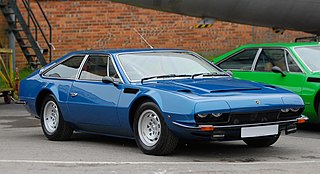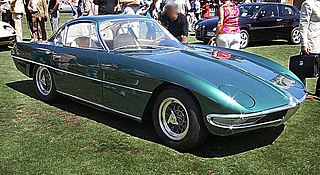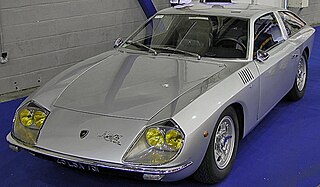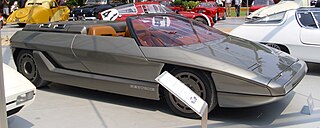
The Lamborghini Countach is a rear mid-engine, rear-wheel-drive sports car produced by the Italian automobile manufacturer Lamborghini from 1974 until 1990. It is one of the many exotic designs developed by Italian design house Bertone, which pioneered and popularized the sharply angled "Italian Wedge" shape.

The Lamborghini Miura is a sports car produced by Italian automaker Lamborghini between 1966 and 1973. The car was the first automobile with a rear mid-engined two-seat layout, although the concept was first seen in a production road car with René Bonnet's Matra Djet, introduced in 1964. This layout has since become the standard for high-performance sports cars. When released, it was the fastest production road car.

Gruppo Bertone, commonly known as Bertone, was an Italian industrial design company which specialized in car styling, coachbuilding and manufacturing. It was also a car manufacturing company. Bertone styled cars for Abarth, Alfa Romeo, Aston Martin, BMW, Citroën, Ferrari, Fiat, Iso, Lancia, Lamborghini, Mercedes-Benz, Opel, and Volvo, among others. In addition, the Bertone studio was responsible for two of the later designs of the Lambretta motor scooter.

Marcello Gandini was an Italian car designer, widely known for his work with the Italian car design house, Bertone, where his work included designing the Alfa Romeo Carabo and Montreal, Lancia Stratos Zero, Maserati Khamsin, Ferrari GT4, Fiat X1/9, and several Lamborghinis, including the Bravo, Miura, Marzal, Espada, Urraco, and Countach. Gandini himself said his design interests prioritised vehicle architecture, construction, assembly, and mechanisms over styling.

The Bugatti EB 110 is a mid-engine sports car initially conceived by Ing. Paolo Stanzani in the mid 1980s and produced by Bugatti Automobili S.p.A. from 1991 until 1995, when the company was liquidated. The model restarted the brand's presence in the automobile industry after a hiatus of nearly 40 years.

The Lamborghini Espada is a 4-seat grand touring coupé built by Italian car manufacturer Lamborghini between 1968 and 1978.

The Lamborghini Islero is a grand tourer produced by Italian automaker Lamborghini between 1968 and 1969. It was the replacement for the 400 GT and featured the Lamborghini V12 engine. The car debuted at the 1968 Geneva Auto Show.

The Lamborghini 350 GT is a grand tourer manufactured by Lamborghini between 1964 and 1966. It was the first production vehicle produced by Lamborghini. The 350 GT was based on the earlier Lamborghini 350 GTV and was equipped with a 3.5 liter V12 engine and a 2-door coupé body by Carrozzeria Touring. The 350 GT debuted at the March 1964 Geneva Motor Show and production began the following May. The success of this model ensured the company's survival, establishing it as a viable competitor with rival manufacturer Ferrari.

The Lamborghini Jarama is a 2+2 grand tourer manufactured and marketed by Italian car manufacturer Lamborghini between 1970 and 1976. It was styled by Bertone designer Marcello Gandini.

The Lamborghini 350 GTV is a Lamborghini prototype and forerunner of the automaker's first production model, the 350 GT. It was first presented to the public at the 1963 Turin Auto Show.

The Lamborghini Flying Star II was a one-off concept car built by Carrozzeria Touring Superleggera in 1966 on a Lamborghini 400 GT chassis. It debuted at the 1966 Turin Auto Show.

The Lamborghini Marzal is a concept car, first presented by Lamborghini at the 1967 Geneva Motor Show.

The Lamborghini Bravo is a concept car designed by Marcello Gandini at Bertone for Lamborghini. It was first presented in 1974 at the Turin Auto Show.

The Lamborghini Athon is a concept car designed by Bertone for Lamborghini.

The Alfa Romeo 33 Stradale is a mid-engine sports car built by Italian automobile manufacturer Alfa Romeo. It was the fastest commercially available car for the standing kilometer upon its introduction. 18 examples were produced between 1967 and 1969. "Stradale" is a term often used by Italian car manufacturers to indicate a street-legal version of a racing car; indeed the 33 Stradale was derived from the Tipo 33 sports prototype. Built in an attempt by Alfa Romeo to make some of its racing technology available to the public, it was also the most expensive automobile for sale to the public in 1968 at US$17,000.
Neri and Bonacini, also known as Nembo, was a small carrozzeria and mechanic shop based in Modena, Italy, active from the late 1950s to around 1967. Founded and run by Giorgio Neri and Luciano Bonacini, the shop worked on and produced bodies for Ferrari, Lamborghini and Maserati road and race cars, both in an official capacity for those manufacturers and for private owners. Their best known projects are the Ferrari 250 GT-based Nembo spiders and the Lamborghini 400GT Monza. Neri and Bonacini also designed a car under their own name, the Neri and Bonacini Studio GT Due Litri. Two prototypes of this car were made between 1966 and 1968 but it never entered series production. The shop closed around 1967 when Bonacini went to work for De Tomaso and Neri started his own shop, Motors-World-Machines (MWM).

Automobili Lamborghini S.p.A. is an Italian brand and manufacturer of luxury automobiles. Lamborghini's production facility and headquarters are located in Sant'Agata Bolognese, Italy. Italian manufacturing magnate Ferruccio Lamborghini founded the company in 1963 with the objective of producing a refined grand touring car to compete with offerings from established marques such as Ferrari. The company's first models were introduced in the mid-1960s and were noted for their refinement, power and comfort. Lamborghini gained wide acclaim in 1966 for the Miura sports coupé, which established rear mid-engine, rear wheel drive as the standard layout for high-performance cars of the era.

The Chevrolet Testudo is a concept car built by Bertone on a modified Chevrolet Corvair Monza platform. The name comes from the Latin word for "Turtle". The car debuted at the 1963 Geneva Motor Show.

The Autobianchi A112 Runabout is a concept car developed by Bertone and first shown in 1969. The small two-seat, mid-engined car was the inspiration for the Fiat X1/9 that appeared in 1972.

The Lancia Stratos Zero or Lancia Stratos HF Zero is a grand tourer concept sports car from the Italian automobile manufacturers Bertone and Lancia. It was presented at the 1970 Turin Auto Show, predating the production Lancia Stratos by three years. It is currently owned by Phillip Sarofim.



















